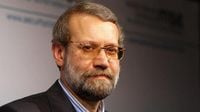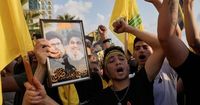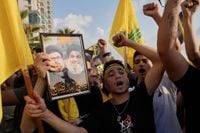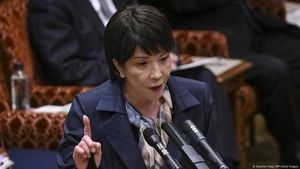On September 27, 2025, the city of Beirut found itself at the center of a diplomatic push for unity in a region long marred by conflict and shifting alliances. Ali Larijani, the head of Iran’s Supreme National Security Council, arrived in the Lebanese capital with a message that resonated far beyond the walls of the parliament: it was time, he urged, for regional countries to set aside their differences and join forces against what he described as “Israel’s conspiracies.”
Larijani’s visit was timed to coincide with the anniversary of the assassination of Hezbollah leader Hassan Nasrallah, a date that carries deep symbolic weight for Iran’s allies in Lebanon. According to The Associated Press, Larijani made his appeal for unity clear during his address, stating that regional cooperation was essential to counter the threats posed by Israel. The choice of Beirut as the stage for these remarks was no accident; Lebanon, with its complex tapestry of political and religious factions, has long been a focal point in the broader struggle between Iran and Israel.
Hezbollah, the Lebanese Shiite militant group and political party, has been a central actor in this drama for over four decades, bolstered consistently by Iranian support. Despite suffering considerable losses in a 14-month war with Israel that ended with a U.S.-brokered ceasefire in November prior to 2025, Hezbollah remains a formidable force. Its resilience, many observers argue, is due in no small part to the backing it receives from Tehran. As Devdiscourse reported, Larijani’s visit underscored the depth of this alliance, with the Iranian official making a point to meet with key Lebanese leaders, including Parliament Speaker Nabih Berri.
Larijani’s diplomatic overtures extended beyond Lebanon’s borders. In his discussions with Berri, he advocated for Saudi Arabia to reconcile its longstanding tensions with Hezbollah. This was a notable gesture, considering the historical rivalry between Iran and Saudi Arabia, as well as the latter’s wariness of Hezbollah’s influence in the region. Yet, Larijani’s argument was straightforward: “We must put aside our differences and cooperate closely as we face Israel’s conspiracies.” His words, as reported by The Associated Press, were a direct call for a united front against a common adversary.
The context for Larijani’s visit—and his urgent call for unity—was shaped by recent events that have reignited hostilities across the region. The latest round of conflict between Israel and Hezbollah was triggered by the Hamas-led assault on southern Israel on October 7, 2023. That attack set off a chain reaction, with Israel launching military operations not only against Hamas in Gaza but also against Hezbollah positions in Lebanon. The resulting violence, as detailed by Devdiscourse, has kept the region on edge, with fears of a broader war never far from the surface.
In his remarks, Larijani did not mince words about Iran’s stance in the face of potential escalation. He assured his Lebanese hosts—and, by extension, other regional players—that Iran and its allies were ready to respond forcefully to any Israeli aggression. “We stand prepared for a strong retaliation if provoked,” he reportedly told Berri, signaling a willingness to raise the stakes should the conflict intensify. This message was as much about deterrence as it was about solidarity, aiming to reassure Iran’s partners while warning its adversaries.
The call for regional unity against Israel, however, is not without its complications. The Middle East is a patchwork of alliances and enmities, where old rivalries die hard and new ones emerge with little warning. Saudi Arabia’s relationship with Hezbollah, for instance, has been marked by deep suspicion, given the group’s ties to Iran and its role in regional conflicts such as the war in Syria. Larijani’s push for reconciliation, therefore, represents both an ambitious diplomatic gambit and a recognition of the limits of unilateral action in a region where no player can afford to stand alone for long.
Hezbollah’s own position has been shaped by years of confrontation with Israel. The group’s 14-month war with Israel, which ended with a U.S.-brokered ceasefire, left it battered but unbowed. Despite significant losses, Hezbollah has managed to maintain its influence in Lebanon and its appeal among segments of the population who view it as a bulwark against Israeli aggression. Iran’s continued support has been crucial in this regard, providing not only material aid but also political backing at critical moments.
Larijani’s visit to Beirut, then, was more than a symbolic gesture. It was a reaffirmation of Iran’s commitment to its allies and a reminder that the region’s conflicts are deeply interconnected. By calling for unity against Israel, Larijani sought to bridge divides that have long hampered collective action among regional states. Whether this appeal will bear fruit remains to be seen, but the urgency of his message reflects the volatile state of affairs in the Middle East as the calendar turns toward the final months of 2025.
The meeting between Larijani and Berri also highlighted the importance of dialogue and diplomacy in a region where military solutions have often proved elusive. By advocating for reconciliation between Saudi Arabia and Hezbollah, Larijani was, in effect, proposing a new framework for regional security—one that prioritizes cooperation over confrontation. This approach, while ambitious, acknowledges the reality that no single country can address the region’s challenges alone.
For Lebanon, Larijani’s visit was a reminder of the country’s precarious position at the heart of regional rivalries. With its fragile political system and history of foreign intervention, Lebanon has often served as a proxy battleground for larger powers. The presence of Iranian officials in Beirut, especially on a day marking the anniversary of Nasrallah’s assassination, underscored the enduring influence of external actors in Lebanese affairs.
As the anniversary events concluded, the message from Tehran was clear: the time for division had passed, and the threats facing the region demanded a united response. Whether regional leaders will heed Larijani’s call remains an open question, but the stakes could hardly be higher. With hostilities simmering and alliances in flux, the path forward will require not only diplomatic skill but also a willingness to confront the hard realities of the region’s fractured politics.
In the end, Larijani’s visit to Beirut was both a warning and an invitation—a warning that the status quo is unsustainable, and an invitation for regional actors to come together in the face of shared challenges. As the dust settles on another anniversary, the eyes of the region—and the world—remain fixed on what comes next.






